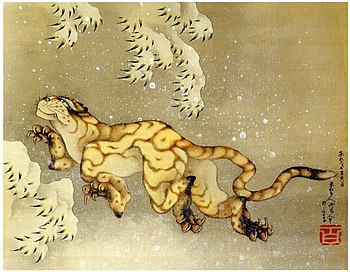Tiger in the Snow
| Tiger in the Snow | |
|---|---|
 | |
| Artist | Katsushika Hokusai |
| Year | 1849 |
| Type | Hanging scroll, ink and paint on silk |
| Dimensions | 39 cm × 50 cm (15.375 in × 19.625 in) |
| Location | Private collection |
Tiger in the Snow is a hanging scroll (kakemono) painted by Japanese ukiyo-e artist Hokusai in 1849. It is one of the last works he produced in his long and prolific career.
History and description
[edit]Towards the end of his life, Hokusai began to draw many large cats. Between 1842 and 1843 Hokusai painted a shishi lion every day as a talisman against bad luck in a practice he called nisshin joma, or "daily exorcisms".[1] In his final, years tigers became a subject matter to which he returned several times.
In the painting the ground is invisible and the tiger seems to float through the snow-filled air. The snow-covered bamboo fronds echo the claws of the tiger.[2] His fur is rendered with wavy lines, a sinuous effect more in keeping with a snake or dragon. The tiger's expression has been variously described as a smile or a snarl, the tiger himself appears joyful, amused,[2] and "royally pleased with himself".[3]
The signed inscription reads: "Month of the Tiger, Year of the Cock, old Manji, the old man mad about painting, at the age of ninety". The work, possibly his last painting, was done just a few months before his death aged eighty-nine by Western reckoning.[2] It shows that even in his old age, Hokusai's powers remained undiminished.[3] Narazaki Muneshige wrote of this painting, "While the artist's body was emaciated and bones wearied by age, in his thoughts he was a charging tiger". The seal reading Hyaku, or "One Hundred", is another sign of Hokusai's preoccupation with longevity.[4]
Art market
[edit]The painting was sold by Christie's auction house for US$772,500 in October 1998.[4] It is held by a private American collector.[2]
References
[edit]- ^ Machotka 2009, p. 214.
- ^ a b c d Calza 2003, p. 503.
- ^ a b Smith, Roberta (7 April 2006). "Hokusai in Washington: A Retrospective of the Restless Japanese Master". New York Times.
- ^ a b "An Important Collection of Japanese Ukiyo-e Paintings: Lot 83". Christie's. Retrieved 3 November 2020.
Sources
[edit]- Machotka, Ewa (2009). Visual Genesis of Japanese National Identity: Hokusai's Hyakunin Isshu. Peter Lang. ISBN 9789052014821.
- Calza, Gian Carlo (2003). Hokusai. Phaidon. ISBN 0714844578.
